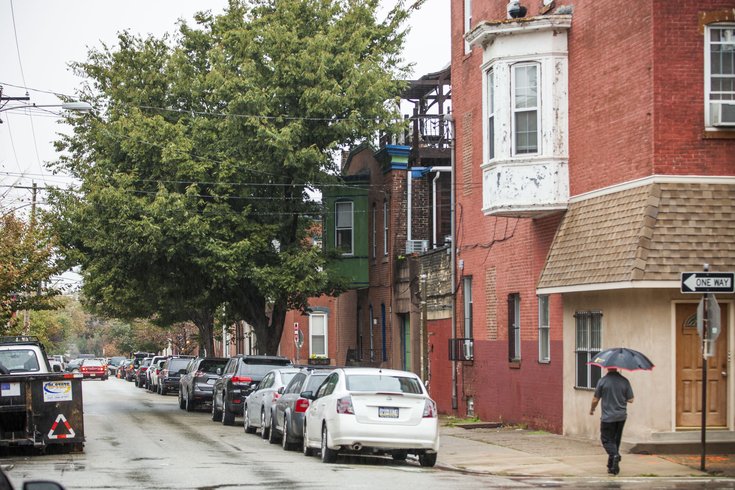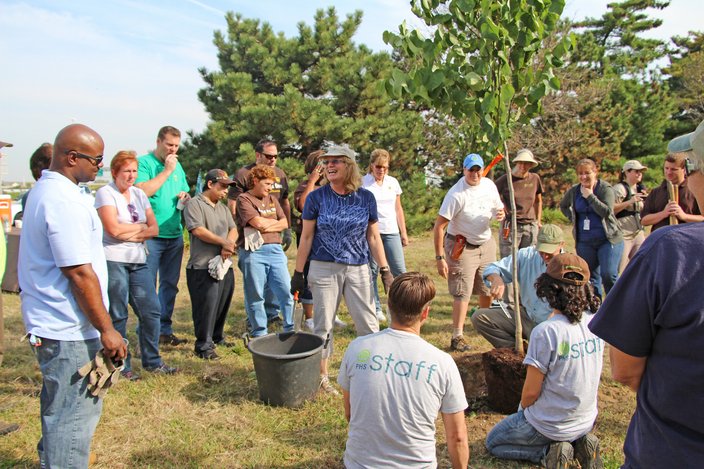
October 05, 2015
 Thom Carroll/PhillyVoice
Thom Carroll/PhillyVoice
Trees on Parrish Street in the Fairmount neighborhood of Philadelphia.
The world is full of questions we all want answers to but are either too embarrassed, time-crunched or intimidated to actually ask. In the spirit of that shared experience, we've embarked on a journey to answer all of the questions that burn in the minds of Philadelphians -- everything from universal curiosities (What's it like to be shot wearing a bulletproof vest?) to Philly-specific musings (How do they clean the Liberty Bell?).
Have a question you're dying to have answered? Send an email to entertainment@phillyvoice.com, and we'll find an expert who can give you the answer you're craving.
Rural folks love to ask urban dwellers about trees -- in fact, it's often one of the first misconceptions to come up in conversation with strangers.
Don't you miss trees? The outdoors? Nature?
But the truth is that urban spaces -- Philadelphia especially, given its history as William Penn's "green country towne" -- don't lack trees and greenery. Quite to the contrary, actually: Just last month, the Pennsylvania Horticultural Society planted its 500,000th tree as part of its regional Plant One Million campaign. Somehow, trees do take up residence in the city -- even if they face trials and tribulations their forest-rooted brethren don't.
Here, we ask Mindy Maslin, project manager for the Pennsylvania Horticultural Society's Tree Tender program, for a rundown of just how those street trees we regularly pass are able to survive in concrete jungles like Philadelphia.
Let’s start with soil: What’s the soil like that trees are able to grow in in cities?
Soil in cities can range drastically from one foot to the next. Oftentimes ... what we assume is soil is really rubble. Which goes to the question: How could trees possibly survive living in the city?
... Trees need water, air, nutrients and room to grow. Those are the four main things they need. And a lot of times, we see trees are planted in normally a three-by-three cut-out pit -- sometimes smaller, which is scary and horrendous, but sometimes larger, which is healthier -- and then the majority of tree roots don't grow very far, only into the top 24 inches of the soil. But they grow wide. Underneath that concrete you’re going to have tree roots making their way to gather those nutrients and oxygen. Tree roots really can’t grow under streets because streets can be load-bearing, so that takes away one-quarter of their growing space. They’re left with the other three-quarters. And it’s not [that roots just grow in the cut-out], but they do grow underneath the sidewalk. And the sidewalk acts, in a weird way, as a mulch. It protects the tree roots from being compacted too badly and provides a little bit of protection and climate-control.
There are really a lot of horrible things that street trees especially have to deal with – de-icing salt, or dogs. Some people think, ‘My dog peed on the tree and it just helps to water it,’ but it messes with the pH balance. It’s an acid, and when one dog goes on a tree, then they all want to go on the tree … You don’t see the damage you’ve done to the bark with the car door right away, but if you do cut through that bark and damage the living tissue underneath, the tree can be damaged for the rest of its life. And wound the bark ... the highways that carry nutrients up and down from the roots to the leaves, once they’ve been tampered [with], they don’t come back.
Don’t buildings block sunlight?
Yes, they can block sunlight, or reflect it. Depending on what the building is made out of, it can make more of a heat island or create kind of a tunnel. ... A lot of times with street trees they look like they’re leaning toward the street, and that’s because they’re seeking out as much sunlight as they can get.
I hear a lot of hoopla over roots growing into pipes. How would you explain that?
The water department came out with a good graphic about this showing that tree roots really stay on the top 24 inches of the soil and pipes are 6 feet down, for the most part. If there’s a leak in the pipe, the tree roots might get in there and exasperate it, but they don’t cause the leak. They don’t naturally go in that area. There’s no reason for them to wrap around and get into metal unless they know there’s something good in there. It’s kind of a fallacy that they cause the problem.
Maslin: The sidewalk acts, in a weird way, as a mulch. It protects the tree roots from being compacted too badly and provides a little bit of protection and climate-control.
How long does a tree live in the city?
There was a study done a few years ago that said the average life expectancy of a tree in the city is under 10 years. That’s a tree in a cutout in the sidewalk. ... If it's planted in a lawn, it would be 40 or 50 years old. And a forest, maybe 100.
So some trees do better in the city than others?
Sure. You want trees that are tolerant of drought, tolerant of compacted soil, tolerant of salt and other poisons in the soil. Some people leave trash around tree roots -- all the trash bags on the tree trunk -- and they leak things that are toxic to the roots and the soil. So trees that are tolerant to those kinds of conditions and are tolerant of air pollution. Those are the main things.
Most common sidewalk tree here?
London planes are really popular in the city. Those are the trees that look like Army fatigue, that have the peeling bark and the balls on them. And the ash trees were pretty common, but they’ll all be dying now because of the emerald ash borer. We’re at risk of losing every ash tree in the city not saved by some sort of intervention. And also honey locust, red maple and tree lilacs are pretty common. Redbuds, cherries, too. And we used to plant a whole bunch of pear trees, but we don’t plant so many of those anymore. They tend to self-destruct.
How many trees are planted in the city right now?
In some parts of the city we’re working toward a 30 percent tree canopy. Some parts of the city, Center City and South Philly, some parts in North Philly, have only 3 percent at this point. Other parts, like parts of the Northwest, have closer to 50 percent. So, just trying to equal that out.
The great thing about the [PHS Tree Tenders] program, and the reason our trees tend to survive, is we don’t just do the planting, but do the education. We educate homeowners on how to care for their trees and get them through that two-year establishment period. That’s critical.
Has there been any kind of scientific progress toward making the city more hospitable for trees?
Sure. Just knowing what trees to plant -- ones that are tolerant of these conditions. A lot of it is citizen knowledge. Science is important, but we know a lot of information that just needs to get out to the people. And there’s a woman who came to one of the Tree Tender classes we had a number of years ago who was lamenting how her tree died and she had taken such good care of it all winter long. Every time it snowed she went out and dumped de-icing salt all around the tree so the snow would melt, and it was heartbreaking because her intentions were great but she didn’t know the ice and snow are great for the tree, it’s a slow release of water. But the de-icing salt was a killer. Knowledge, I think, is what’s really critical.
In a nutshell, how do trees survive in a city like Philadelphia?
Trees adapt because they’re amazing. Like any successful urban dweller, they take advantage of limited resources available to them and adapt. The trees that are the most successful are those that are best at adapting. Human help is key to urban tree survival -- a little help in the way of weeding, aerating the soil, mulching and watering increase and, in fact, are key to urban tree survivability.
